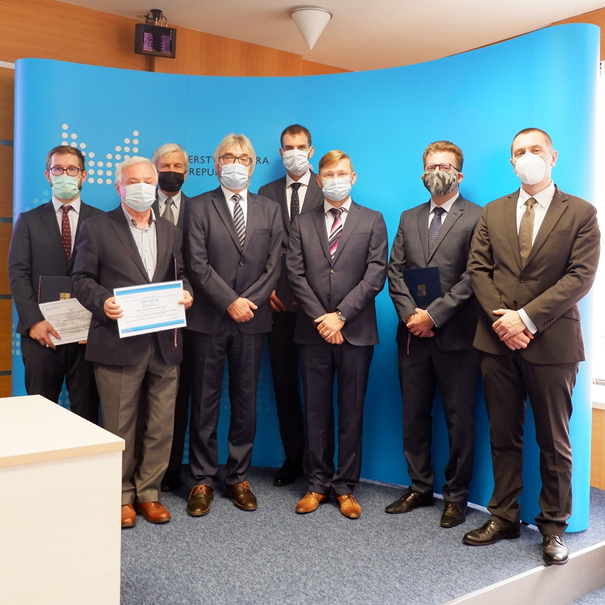Award of the Minister of the Interior of the Czech Republic for Extraordinary Results in the Field of Security Research for 2020


The award of the Minister of the Interior of the Czech Republic for extraordinary results in the field of security research was won by a research team composed of representatives of the Research Center Rez and the Czech Technical University in Prague. The award was handed over on 24 September 2020.
The award for this year was won by a team of researchers composed of Messrs Miroslav Hrehor, Marek Ruscak, Guido Mazzini, Ph.D., assoc. prof. Jaroslav Kluson and Tomáš Urban, Ph.D. for the results achieved in solving two consecutive R&D projects entitled "Prevention, preparedness and mitigation of the consequences of severe accidents of Czech nuclear power plants in connection with new findings of stress tests after the Fukushima accident" and "Refinement of prediction of radiation consequences of severe accidents of nuclear power plants in order to identify their risks”.
Both projects were a response to the accident at the Fukushima nuclear power plant in 2011 and to subsequent stress tests ordered by the European Commission for operating nuclear power plants in the countries of the European Union. The projects were thematically focused on the refinement of analyzes of the time course and radiation consequences of severe accidents at the Dukovany and Temelín nuclear power plants. At the same time, they provided the state nuclear safety authority SÚJB and state administrations with knowledge, methodologies and tools for the effective management of severe accidents and the minimization of their consequences.
The projects were financially supported by the Ministry of the Interior of the Czech Republic within the Security Research Program of the Czech Republic in 2010-2015 and the Security Research Program for the needs of the state in 2010–2020.
The award of the Minister of the Interior has been regularly presented since 2011. Its main goal is to recognize the authors of excellent results in the field of security research in order to motivate them for further interest about research activities and promote their results.
The main objective of the projects was to develop and improve computational models of both types of power plants in order to deepen knowledge about the course of these accidents and their radiation consequences and thus contribute to improving preparedness to reduce the consequences of such accidents. Models of both types of power plants were created in the MELCOR version code (version 1.8.6 and 2.1, 2.2).
The ability of the MELCOR code and the research team to correctly simulate the course of severe accidents was verified on simulation of selected experiments carried out within the PHEBUS - FP project (IRSN, France) and the OECD / NEA project "THAI - Thermal-hydraulics, Hydrogen, Aerosols and Iodine Project". Results were the subject of review by a special SUJB commission for analyzes of beyond design basis accidents with the subsequent granting of a SÚJB certificate.
The project then continued performing computational simulations of selected accident scenarios leading to the melting of the reactor core, namely:
- complete loss of power supply - SBO (Station Blackout)
- loss of steam generators feedwater system with consequent loss of power supply
- large LOCA (Loss of Coolant Accident) + SBO (LOCA + SBO)
- middle LOCA on the connecting pipe of the presurisser + SBO
- small LOCA (Ø100 mm) + SBO.
The analysis of degradation processes of active zones during emergency scenarios provided the course of temperatures, pressures, time evolution of gases (hydrogen) and especially the estimation of the mass and dynamics of the release of fission products into the containment (so-called source terms).
The determination of source terms enabled the creation of a calculation model of the VVER 1000 nuclear power plant (Temelín) in the SCALE code (MONACO module within the MAVRIC calculation sequence) for calculations of the radiation situation in service technological areas of nuclear power plants (control rooms, emergency control rooms, etc.).
The created computational models VVER 1000, VVER 440 and the obtained results will be used for the purpose of design assessment and justification of technical and organizational measures to mitigate the radiation consequences of severe accidents, such as additional technology modifications (eg passive autocatalytic hydrogen recombiners (PAR), emergency filtered ventilation containment system (FCVS), hydrogen burners, retention of corium in the reactor pressure vessel, etc.), but also for the optimization of emergency management programs (EOP - Emergency Operating Procedures and SAMG - Severe Accident Management Guidelines), preparation and assessment of internal and external emergency plans, etc., especially within the SÚJB approval procedures.
The project fulfilled the results of the Ministry of the Interior's security research program by contributing to the identification, prevention and protection against potential threats to the safety of critical infrastructures (nuclear power plants) and thus strengthening the security of the state and citizens.
Miroslav Hrehor
National Radiation Protection Institute (SURO)
miroslav.hrehor@suro.cz
Jitka Miksova
National Radiation Protection Institute (SURO)
jitka.miksova@suro.cz